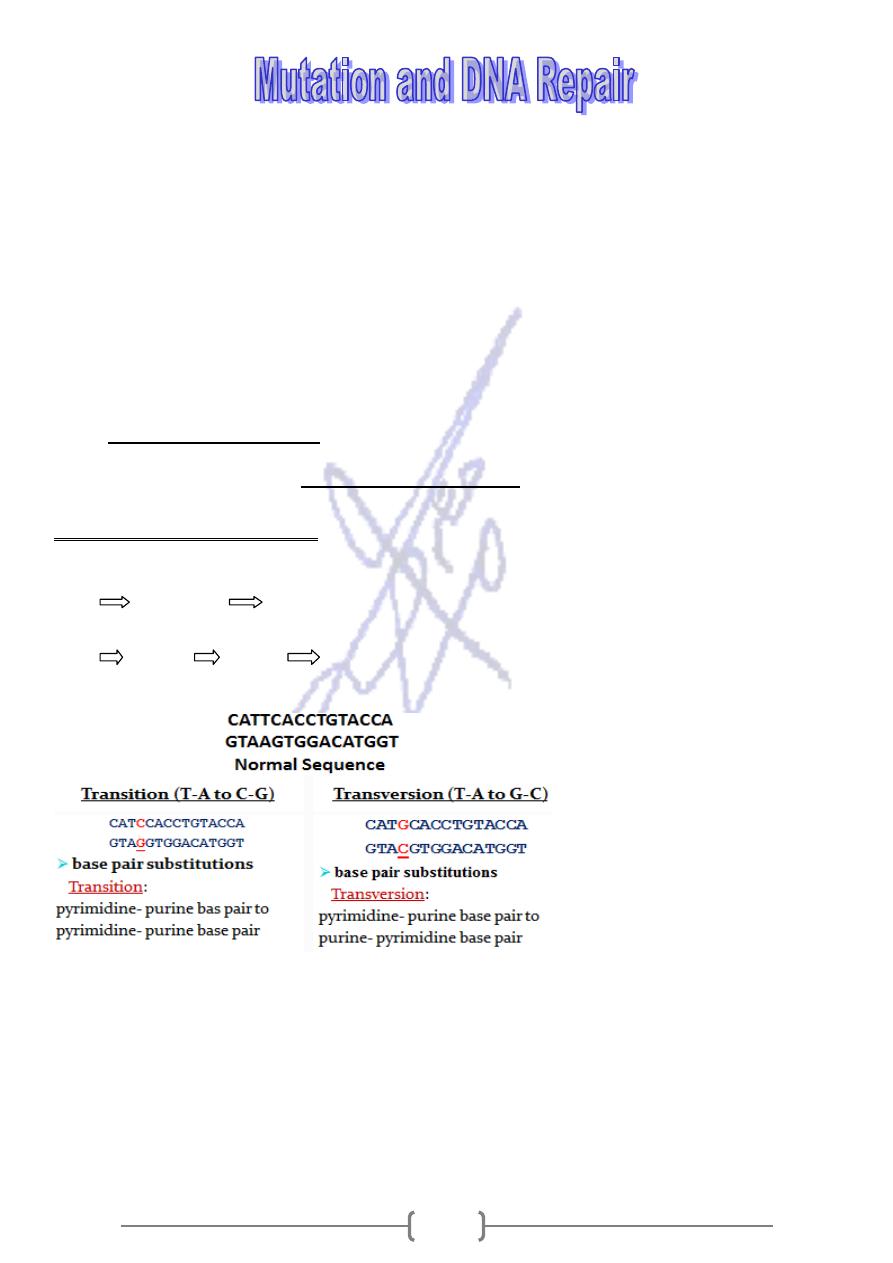
114
A
mutation:
is any heritable change in the genetic material, resulting in an alteration of the DNA
sequence.
* Mutations are usually considered as a change that alters gene function and thus the
phenotype of the organism.
* Some results in genetic diseases, but others have no physical effects.
* Some mutations consist of an alteration of the number or structure of chromosomes in a cell
(abnormalities involve loss or gain of chromosomes or breakage and rejoining of chromatids).
* Other mutations can take place in coding DNA or in regulatory sequences (single-gene
mutation).
Types of mutation
segment are of several types:
coding properties of a DNA
Mutations, which can alter the
pair substitutions
-
Base
-
1
Convert or replaced one type of base pair into another.
* G-C A-T and A-T G-C changes are referred to as transition mutations (replacement of a
purine to pyrimidine base pair by a purine to pyrimidine base pair).
* T-A G-C, G-C C-G, A-T T-A are called transversions (replacement of a pyrimidine -
purine base pair by a purine - pyrimidine base pair).
-
This type of mutation (Base- pair substitutions)
can change the codon to that of another amino
acid, thus altering the protein.
- In addition, such changes can also create a stop codon in which one base pair is replaced by
another. This can result in a change in amino acid sequence.
- Although transitions are more common than transversions, both kinds of mutations occur as a
consequence of replication errors, both can result from chemical damage to DNA, and both have
been implicated as causative factors in inherited genetic disease and cancer.
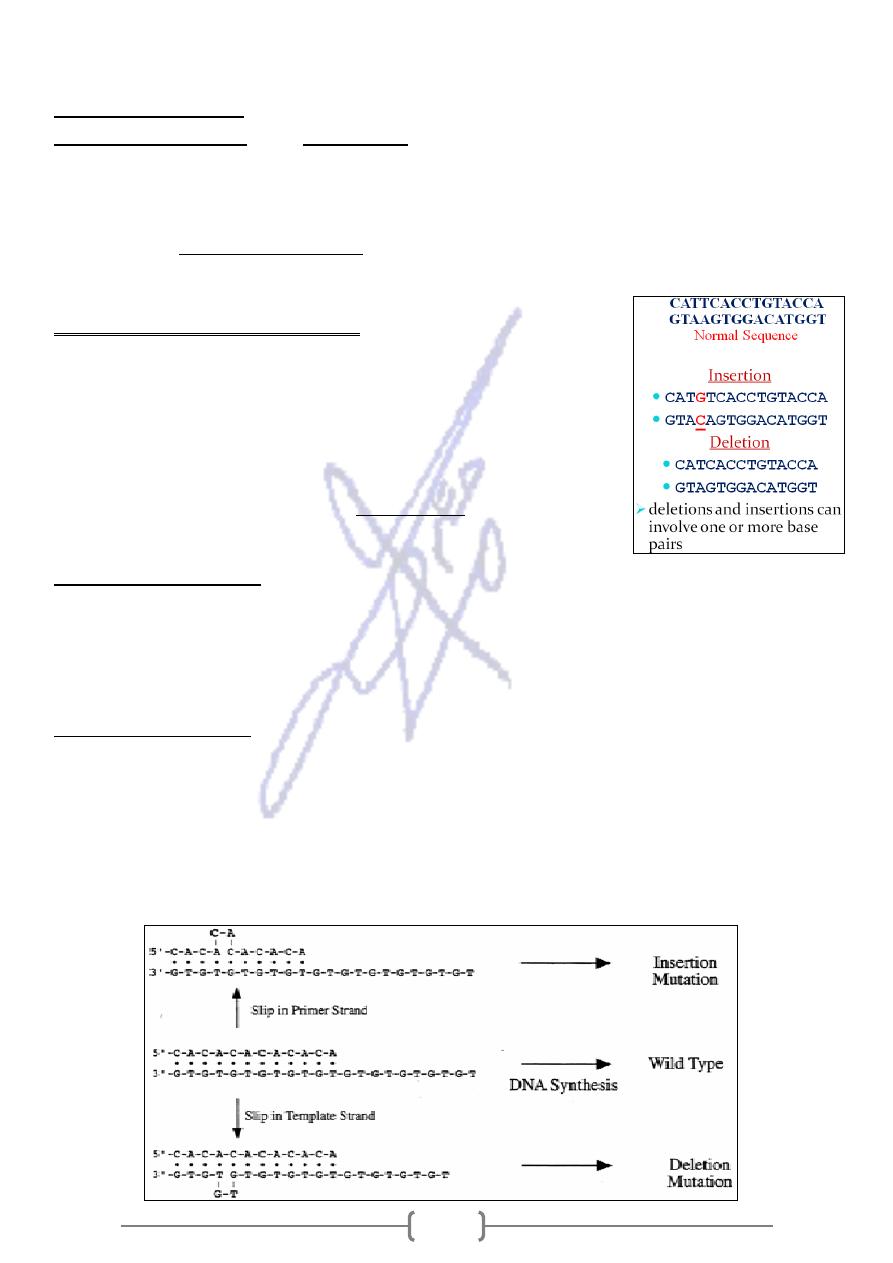
115
There are two types of base- pair substitutions:
which produce change in a single amino acid
A. Missense mutations:
UAA, UAG, or
codons (
of the three stop
produce one
which
B. Nonsense mutations:
UGA) in the mRNA.
* Because the stop codons terminate the translation of mRNA, nonsense mutation results in
a premature termination of the polypeptide chain.
so that it encodes an amino acid, an abnormally
a stop codon is altered
Conversely, if
*
elongated polypeptide is produced.
Small insertions / deletions
-
2
comprise a second common class of mutation.
* Genetic changes involve insertion or loss of a small number of base
pairs (one to several hundred).
* These mutations can results in extra or missing amino acids in a
protein.
cystic
that causes
3 bp deletion
of such mutation is the
An example
-
fibrosis.
2.1: Frameshift mutation:
Another type of deletion and insertion tend to be especially harmful when the number of
missing or extra base pairs is not a multiple of three. Because codons consist of groups of
3bp, such insertions or deletions can alter all the downstream codons, and produced
truncated polypeptide.
2.2: Promoter mutation:
The affinity of RNA polymerase to bind a promoter site is decrease, resulting in reduced
production of mRNA, and final result is decreased production of a protein. Also mutations of
transcription factor genes or enhancer sequences have the similar effects.
* Repetitive runs of a mono, di-, or trinucleotide sequence are extremely prone to insertion
/deletion mutation, an effect that has been attributed to slippage of template and primer
strands during DNA replication

116
2.3: Splice site mutation:
Mutation interfere with the splicing of introns as a mature mRNA is formed from the primary
mRNA transcript, and alter the splicing signal that is necessary for proper excision of an intron.
* Mutations can be also caused by expanded tandem repeats DNA sequences (satellite)
which are prone to insertion /deletion as a result of unequal crossover or unequal sister
chromatid exchanges
So the principle types of mutations are:
Missens, Nonsense, Frameshift, Promoter, Splice site
Causes of Mutation
* Mutations can be induced in our DNA by exposure to a variety of mutagens occurring in
our external environment or to mutagens generated in the intracellular environment.
* A large number of agents known to cause induced mutations. These mutations due to
known environmental causes are called spontaneous mutations, which are naturally
arising during the process of DNA replication and repair (endogenous).
* Mutagens: Agents that cause induced mutations
Types of Mutagens
1. Radiation:
* Ionizing radiation, produced by X- rays and nuclear fall-out, can eject electrons from
atoms, forming electrically charged ions.
When these ions are situated within or near the DNA molecule, they can promote
chemical reactions that change DNA bases, and can also break the bonds of the double-
stranded DNA.
* Nonionizing radiation: produced by UV radiation which occurs naturally in sunlight.
It does not form charged ions but can move electrons from inner to outer orbits within
an atom, and the atom becomes chemically unstable.
* UV radiation causes the formation of covalent bonds between adjacent pyrimidine base,
base
and are unable to pair properly with purines during DNA replication, this results in a
pair substitution
* Sunlight is particularly damaging to DNA. This figure shows the formation of a thymine
dimer, catalyzed by UV light. The thymine dimer bridges two adjacent thymine residues on
the same DNA strand. Dimer is (a molecule having two subunits).
* Because UV radiation is absorbed by the epidermis, it does not reach the germ line but
can cause skin cancer.
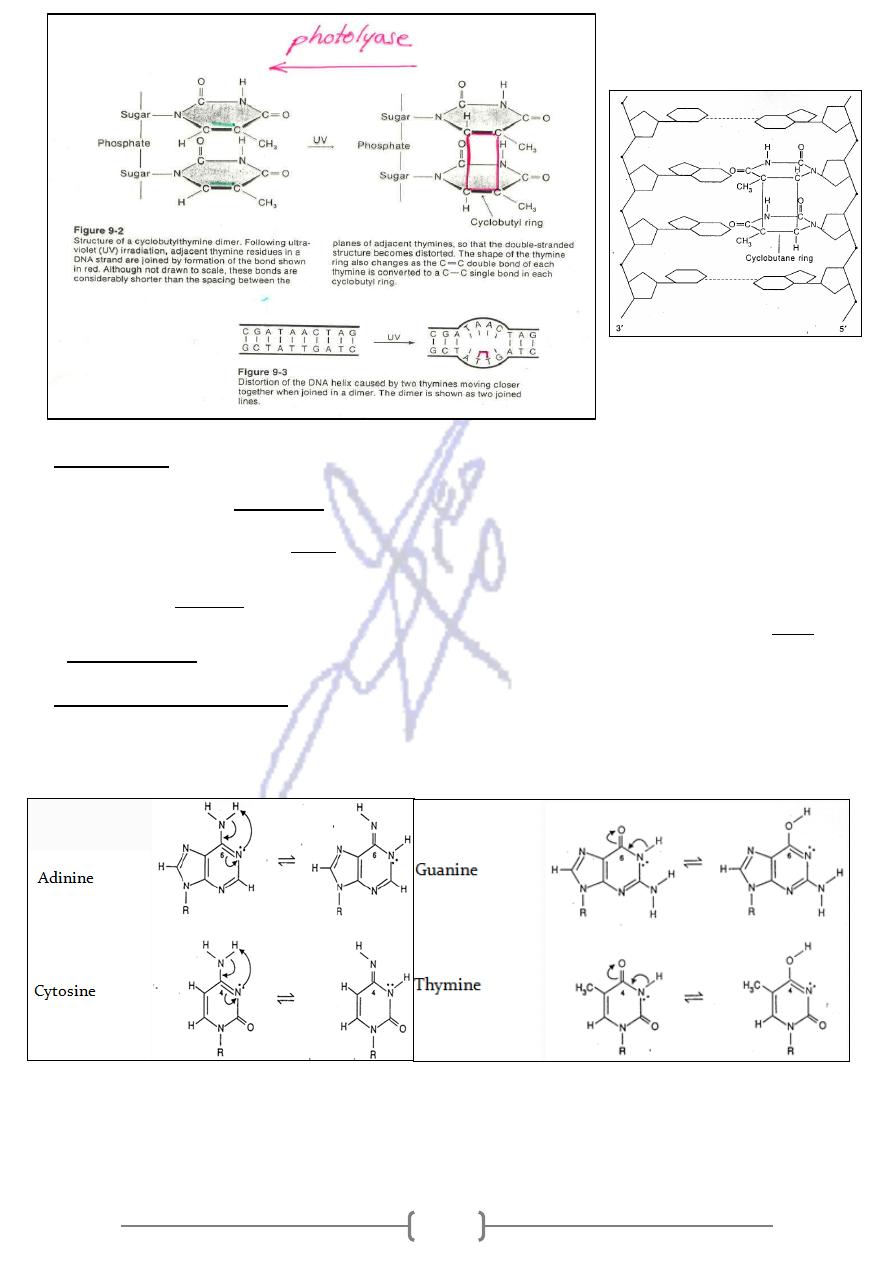
117
Because of their chemical similarity to DNA bases (base analogs).
2. Chemicals:
for a true DNA base during replication.
substituted
can be
Bromouracil:
*
themselves between existing bases causing frameshift
insert
can physically
Acridin dyes:
*
mutation.
and pairs with
amino group from cytosine, converting it to uracil,
an
removes
Nitrous acid:
*
base
adenine instead of guanine, as the original cytosine would have done. The end result is a
.
pair substitution
(those that result from no external cause)
3. Spontaneous mutations
* Spontaneous mutations can occur by rearrangement of bonds and by the repositioning of
hydrogens in the purine and pyrimidine bases
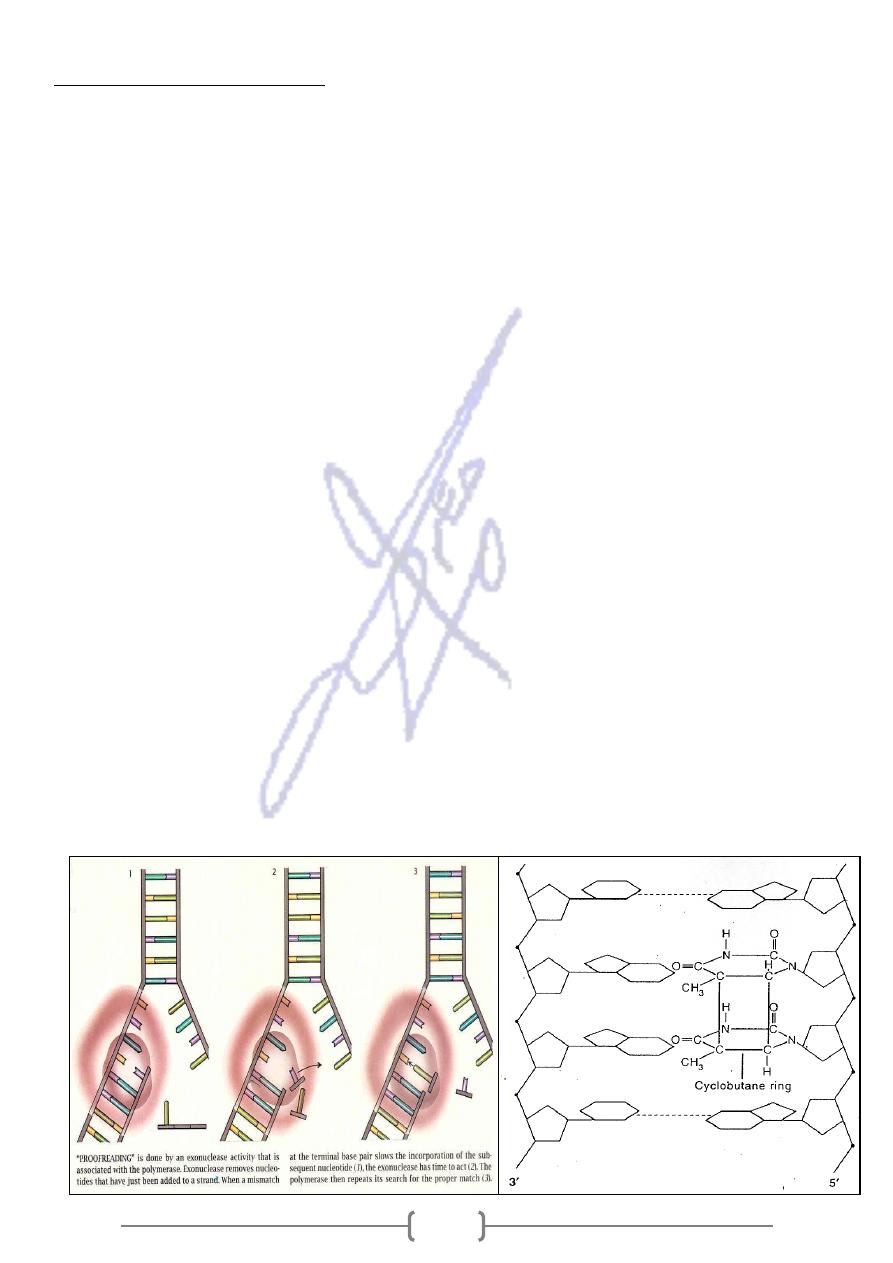
118
Mechanisms of DNA Repair
1. Mutations that occur during DNA replication are repaired when possible by proofreading by the
DNA polymerases
2. Mutations that are not repaired by proofreading are repaired by mismatch (post-replication)
repair followed by excision repair
3. Mutations that occur spontaneously any time are repaired by excision repair (base excision or
nucleotide excision)
* For DNA to be repaired properly following the mismatch incorporation of a nucleotide into
the newly synthesized DNA strand, the replication machinery must have a means by which to
distinguish between the "old" (template) strand and the "new" (daughter).
* Several dozen enzymes are involved in the repair of damaged DNA. They collectively
recognize the altered base, excise it by cutting the DNA strand, replace it with the correct
base and reseal the DNA.
* There are two types of excision repair:
- base excision repair and
- nucleotide excision repair .
* Defects in DNA repair system can lead to many types of disease. For example, inherited
mutation in genes responsible for DNA mismatch repair result in the persistence of cells with
replication errors (mismatches) and lead to some kinds of cancers.
* Fail to repair double- stranded DNA breaks can lead specifically to ovarian and /or breast
cancer.
* Nucleotide excision repair occurs when the DNA lesion is larger, for example when there is a
thymine dimer.
* In this case, a special repair exconuclease removes about 30 nucleotides, including the lesion.
The DNA is then resynthesized and ligated together as with base excision repair.
* Defect in excision repair lead to a number of diseases like xeroderma pigmentosum
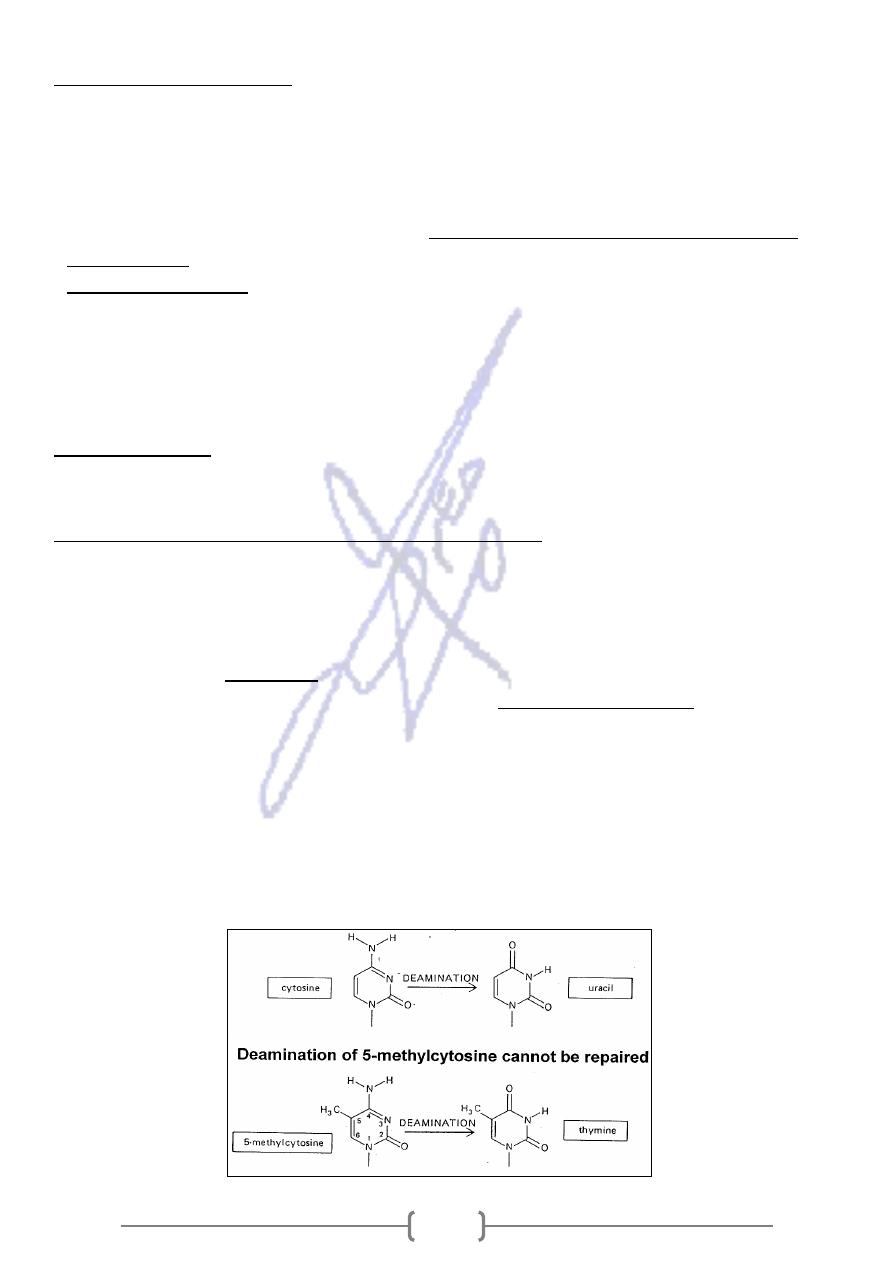
119
xeroderma pigmentosum
* Xeroderma pigmentosum: A genetic disease characterized by such extraordinary sensitivity
to sunlight that it results in the development of skin cancer at a very early age. Children with
xeroderma pigmentosum (XP) can only play outdoors safely after nightfall. They have been
called midnight children.
failed to remove pyrimidine dimers in the DNA
occurs due to
Xeroderma pigmentosum (XP)
*
ting replication errors lead to
after exposure to UV radiation, and the resul
of the skin cells
in skin cells.
base pair substitution
* XP usually begins within the first 10 years of life. The skin is dry and scaly (xeroderma), and
extensive freckling and abnormal skin pigmentation (pigmentosum) are followed by
numerous skin tumors. Patients with XP can develop sever malignancies that some times
result in death before 20 years of age.
Mutation Rates
At the level of the gene, the mutation rate ranging from 10
- 4
to 10
- 7
per locus per cell division.
:
There are at least two reasons for the large range of variation
1. Gene size: larger genes present large "targets" for mutation than do smaller genes.
2. Certain nucleotide sequences are susceptible to mutation. These are called mutation hot spots.
The best known example is the two- base (dinucleotide) sequence CG. In mammals about 80% of
: a methyl group is attached to the cytosine base. The methylated
methylated
are
CG dinucleotides
, resulting
converting it to thymine
methylcytosine easily loses an amino group,
-
cytosine, 5
mutation from cytosine to thymine.
The problem that arises from these methylations is that deamination of a 5 methyl cytosine
results in the production of thymine, which is not foreign to DNA. Thus, while a base pair
mismatch is seen in the DNA by the repair machinery, it does not know which of the two strands
to repair.
3. Mutation rates also affected with the age of the parent

111
Molecular consequences of Mutation:
Mutations can produce either:
* a gain of function or * loss of function of the protein product
* Gain- of- function result in over expression or inappropriate expression of the product (in the
wrong tissue or in the wrong stage of development).
Gain- of- function mutations produce dominant disorders.
* Dominant negative mutations, result in a protein product that is not only nonfunctional but
also inhibits the function of the protein produced by the normal allele
* Loss- of- function mutations are seen in recessive diseases. In such diseases, the mutation
results in the loss of 50% of the protein product (e.g. metabolic enzymes), but the 50% that
remains is sufficient for normal function.
* Diseases involving haplo insufficiency: in which 50% of the gene product is insufficient for
normal function and dominant disorder can result.
E.g. familial hypercholesterolemia, in this disease, a single copy of mutation reduces the
number of low-density lipoprotein (LDL) receptors by 50%, so cholesterol levels are double
than normal resulting in increase the risk of heart disease.
